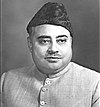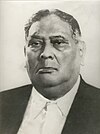The allocation of 250 seats in the assembly was based on the communal award. It is illustrated in the following.[1]
- General elected seats- 78
- Muslim electorate seats- 117
- Urban seats- 6
- Rural seats- 111
- Anglo-Indian electorate seats- 3
- European electorate seats- 11
- Indian Christian electorate seats- 2
- Zamindar seats- 5
- Labour representatives- 8
- Education seats- 2
- Women seats- 5
- General electorate- 2
- Muslim electorate- 2
- Anglo-Indian electorate- 1
- Commerce, Industries and Planting seats- 19
- Jahanara Begum: The Bengal Legislature of 1937 and Its Characteristics. Proceedings of the Indian History Congress, Vol. 36 (1975), pp. 485–492 (online version at JSTOR)
- David Denis Taylor: Indian Politics and the Elections of 1937. D.Phil. thesis, University of London 1971. ProQuest Number: 11010433 (online version)
- Shila Sen: Muslim Politics in Bengal 1937-47. Impex India: New Delhi, 1976 (online summary)


